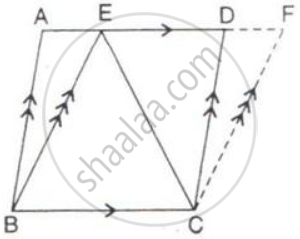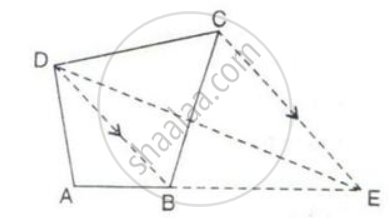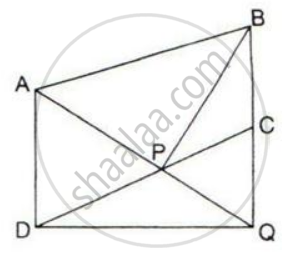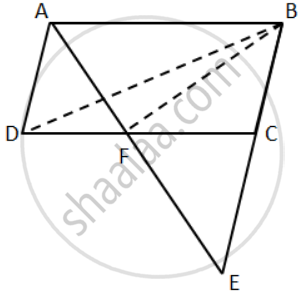Advertisements
Advertisements
प्रश्न
In the given figure, diagonals PR and QS of the parallelogram PQRS intersect at point O and LM is parallel to PS. Show that:
(i) 2 Area (POS) = Area (// gm PMLS)
(ii) Area (POS) + Area (QOR) = Area (// gm PQRS)
(iii) Area (POS) + Area (QOR) = Area (POQ) + Area (SOR).
उत्तर
(i) Since POS and parallelogram, PMLS are on the same base PS and between the same parallels i.e. SP//LM.
As O is the center of LM and the Ratio of the area of triangles with the same vertex and bases along the same line is equal to the ratio of their respective bases.
The area of the parallelogram is twice the area of the triangle if they lie on the same base and in between the same parallels.
So 2(Area of PSO)=Area of PMLS
Hence Proved.
(ii) Consider the expression: Area ( ΔPOS) + Area ( QOR ):
LM is parallel to PS and PS is parallel to RQ, therefore, LM is
Since triangle POS lie on the base PS and in between the parallels PS and LM, we have,
Area ( ΔPOS ) = `1/2"Area"( square` PSLM )
Since triangle QOR lie on the base QR and in between the Parallels LM and RQ, we have,
Area ( ΔQOR ) = `1/2"Area" ( square` LMQR )
Area ( ΔPOS ) + Area ( ΔQOR ) = `1/2"Area"( square` PSLM ) + `1/2"Area"( square` LMQR )
= `1/2 ["Area (PSLM )" + "Area" ( square` LMQR )]
= `1/2["Area" ( square` PQRS) ]
(iii) In a parallelogram, the diagonals bisect each other.
Therefore, OS = OQ
Consider the triangle PQS, since OS = OQ, OP is the median of the triangle PQS.
We know that the median of a triangle divides it into two triangles of equal area.
Therefore,
Area ( ΔPOS) = Area ( ΔPOQ ) ....(1)
Similarly, since OR is the median of the triangle QRS, we have, Area ( ΔQOR ) = Area ( ΔSOR ) ....(2)
Adding equations (1) and (2), we have,
Area ( ΔPOS ) + Area( ΔQOR) = Area ( ΔPOQ ) + Area( SOR)
Hence Proved.
APPEARS IN
संबंधित प्रश्न
The given figure shows the parallelograms ABCD and APQR.
Show that these parallelograms are equal in the area.
[ Join B and R ]
ABCD and BCFE are parallelograms. If area of triangle EBC = 480 cm2; AB = 30 cm and BC = 40 cm.
Calculate :
(i) Area of parallelogram ABCD;
(ii) Area of the parallelogram BCFE;
(iii) Length of altitude from A on CD;
(iv) Area of triangle ECF.
In the following figure, CE is drawn parallel to diagonals DB of the quadrilateral ABCD which meets AB produced at point E.
Prove that ΔADE and quadrilateral ABCD are equal in area.
ABCD is a parallelogram a line through A cuts DC at point P and BC produced at Q. Prove that triangle BCP is equal in area to triangle DPQ.

ABCD is a parallelogram in which BC is produced to E such that CE = BC and AE intersects CD at F.
If ar.(∆DFB) = 30 cm2; find the area of parallelogram.
ABCD is a parallelogram. P and Q are the mid-points of sides AB and AD respectively.
Prove that area of triangle APQ = `1/8` of the area of parallelogram ABCD.
In the given figure, the diagonals AC and BD intersect at point O. If OB = OD and AB//DC,
show that:
(i) Area (Δ DOC) = Area (Δ AOB).
(ii) Area (Δ DCB) = Area (Δ ACB).
(iii) ABCD is a parallelogram.

E, F, G, and H are the midpoints of the sides of a parallelogram ABCD.
Show that the area of quadrilateral EFGH is half of the area of parallelogram ABCD.
The given figure shows a parallelogram ABCD with area 324 sq. cm. P is a point in AB such that AP: PB = 1:2
Find The area of Δ APD.
Show that:
The ratio of the areas of two triangles on the same base is equal to the ratio of their heights.
